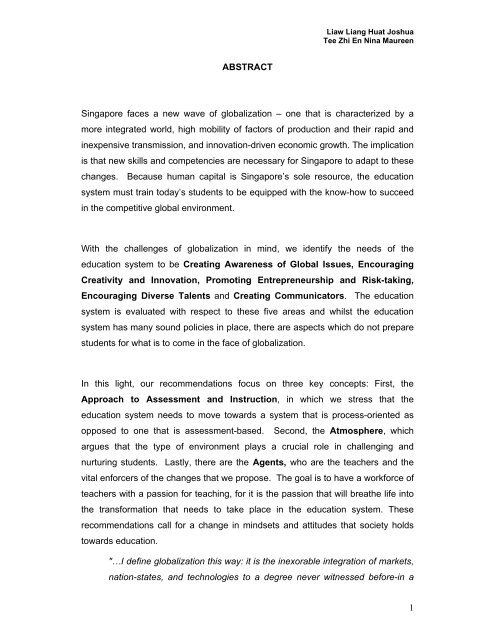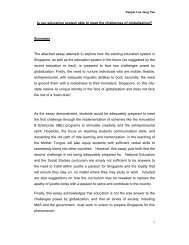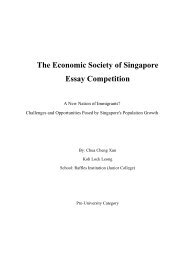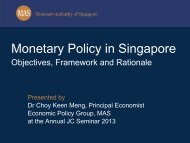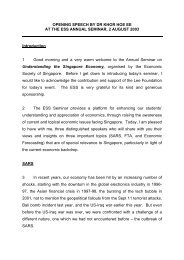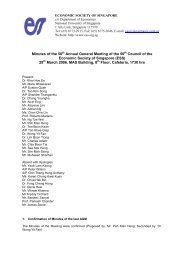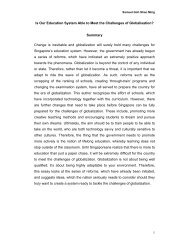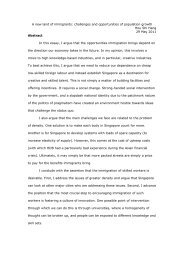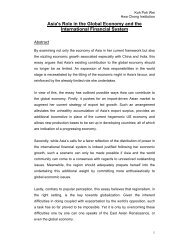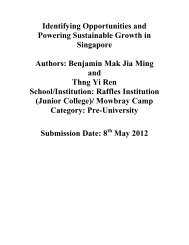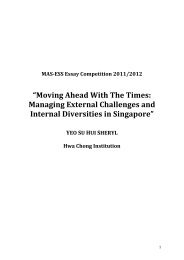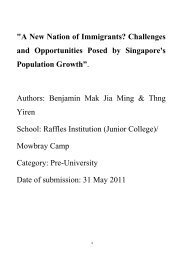Mr Joshua Liaw/Ms Maureen Tee Zhi En - Economic Society of ...
Mr Joshua Liaw/Ms Maureen Tee Zhi En - Economic Society of ...
Mr Joshua Liaw/Ms Maureen Tee Zhi En - Economic Society of ...
- No tags were found...
You also want an ePaper? Increase the reach of your titles
YUMPU automatically turns print PDFs into web optimized ePapers that Google loves.
<strong>Liaw</strong> Liang Huat <strong>Joshua</strong><br />
<strong>Tee</strong> <strong>Zhi</strong> <strong>En</strong> Nina <strong>Maureen</strong><br />
ABSTRACT<br />
Singapore faces a new wave <strong>of</strong> globalization – one that is characterized by a<br />
more integrated world, high mobility <strong>of</strong> factors <strong>of</strong> production and their rapid and<br />
inexpensive transmission, and innovation-driven economic growth. The implication<br />
is that new skills and competencies are necessary for Singapore to adapt to these<br />
changes. Because human capital is Singapore’s sole resource, the education<br />
system must train today’s students to be equipped with the know-how to succeed<br />
in the competitive global environment.<br />
With the challenges <strong>of</strong> globalization in mind, we identify the needs <strong>of</strong> the<br />
education system to be Creating Awareness <strong>of</strong> Global Issues, <strong>En</strong>couraging<br />
Creativity and Innovation, Promoting <strong>En</strong>trepreneurship and Risk-taking,<br />
<strong>En</strong>couraging Diverse Talents and Creating Communicators. The education<br />
system is evaluated with respect to these five areas and whilst the education<br />
system has many sound policies in place, there are aspects which do not prepare<br />
students for what is to come in the face <strong>of</strong> globalization.<br />
In this light, our recommendations focus on three key concepts: First, the<br />
Approach to Assessment and Instruction, in which we stress that the<br />
education system needs to move towards a system that is process-oriented as<br />
opposed to one that is assessment-based. Second, the Atmosphere, which<br />
argues that the type <strong>of</strong> environment plays a crucial role in challenging and<br />
nurturing students. Lastly, there are the Agents, who are the teachers and the<br />
vital enforcers <strong>of</strong> the changes that we propose. The goal is to have a workforce <strong>of</strong><br />
teachers with a passion for teaching, for it is the passion that will breathe life into<br />
the transformation that needs to take place in the education system. These<br />
recommendations call for a change in mindsets and attitudes that society holds<br />
towards education.<br />
"…I define globalization this way: it is the inexorable integration <strong>of</strong> markets,<br />
nation-states, and technologies to a degree never witnessed before-in a<br />
1
<strong>Liaw</strong> Liang Huat <strong>Joshua</strong><br />
<strong>Tee</strong> <strong>Zhi</strong> <strong>En</strong> Nina <strong>Maureen</strong><br />
way that is enabling individuals, corporations and nation-states to reach<br />
around the world farther, faster, deeper and cheaper than ever before . . .<br />
the spread <strong>of</strong> free-market capitalism to virtually every country in the world 1 ."<br />
A century ago, the shores <strong>of</strong> the Singapore River were humming with economic<br />
activity as tongkangs brought goods from China, Europe, India and other parts <strong>of</strong><br />
the region to be stored, transshipped and consumed in Singapore. In addition,<br />
Singapore’s rising fortunes in trade drew immigrants to its shores. Most<br />
immigrants were endowed with no skills but they brought with them a hunger to<br />
find a better life than that <strong>of</strong> their homelands. Both people and goods flowed freely<br />
in the absence <strong>of</strong> tariffs and immigration restrictions.<br />
Fast-forward hundred years: the shores <strong>of</strong> the Singapore River are still bustling<br />
with economic activity, mercantile trade still flourishes, and foreign pr<strong>of</strong>essionals<br />
still look to Singapore for better prospects. In fact, it looks as if little has changed<br />
for Singapore with regards to globalization. Today, many goods are not subjected<br />
to tariffs and Singapore still maintains a fairly open immigration policy.<br />
However, the new game <strong>of</strong> globalization is being told with different stories – those<br />
<strong>of</strong> foreign direct investments, outsourcing, information technology and so on.<br />
Twenty-first century globalization is characterized by the relative mobility <strong>of</strong> factors<br />
<strong>of</strong> production, its rapid and inexpensive transmission, and growth that is driven by<br />
innovation rather than merely efficiency. Correspondingly, new skills and new<br />
competencies are required for Singapore to meet these challenges <strong>of</strong><br />
globalization, find its unique niche in the world, and to fit into the global market.<br />
With Singapore’s only resource being its human capital, it is evident that<br />
Singapore must train the young to be prepared and equipped with these skills and<br />
competencies. Academics have concurred that one <strong>of</strong> the key reasons for<br />
1<br />
Friedman, Thomas L. (2000). “The Lexus and the Olive Tree”. London: Harper-Collins. p.7-8<br />
2
<strong>Liaw</strong> Liang Huat <strong>Joshua</strong><br />
<strong>Tee</strong> <strong>Zhi</strong> <strong>En</strong> Nina <strong>Maureen</strong><br />
Singapore’s rapid economic development was its education system 2 . As the<br />
education system plays an important role in shaping the skills that the labor force<br />
will eventually have, thus, it is necessary to examine Singapore’s education<br />
system in order to obtain insights on whether we have the ingredients to cook up a<br />
competitive labor force attuned to a global environment.<br />
2<br />
Morris (1996) and Kwon (1997).<br />
3
<strong>Liaw</strong> Liang Huat <strong>Joshua</strong><br />
<strong>Tee</strong> <strong>Zhi</strong> <strong>En</strong> Nina <strong>Maureen</strong><br />
WHAT ARE THE CHALLENGES OF GLOBALIZATION IN EDUCATION<br />
In this section, we identify the needs <strong>of</strong> the education system in the light <strong>of</strong> new<br />
challenges brought about by globalization.<br />
Creating Awareness <strong>of</strong> Global Issues<br />
We define awareness in two aspects – knowing the fact and understanding its<br />
interpretation. Awareness is an important issue to address because able<br />
participants <strong>of</strong> globalization need to be knowledgeable <strong>of</strong> world issues. It is<br />
hopelessly insufficient to be merely aware <strong>of</strong> local issues as the world becomes<br />
increasingly interlinked by global networks. Seemingly independent events<br />
happening in one part <strong>of</strong> the world would bring about domino effects to the rest <strong>of</strong><br />
the world. We need to be aware <strong>of</strong> current affairs in multidisciplinary fields and<br />
understand how they affect the world and us. With the embrace <strong>of</strong> globalization,<br />
ignorance is a luxury that we can ill afford.<br />
<strong>En</strong>couraging Creativity and Innovation<br />
As globalization becomes a ubiquitous fact-<strong>of</strong>-life, it is pertinent for an advanced<br />
economy to shift production up the value chain in order to move out <strong>of</strong> activities<br />
that do not command a competitive advantage. The lowest stage <strong>of</strong> the value<br />
chain consists <strong>of</strong> agricultural/mineral extraction, followed by activities such as<br />
manufacturing and distribution. Developing economies typically have an inherent<br />
dominance in these sectors because <strong>of</strong> their lower cost structures that afford them<br />
a competitive advantage. Product creation and innovation occupies the highest<br />
stage in the value chain, and is fuelled by a research and development capability.<br />
Hence, it is imperative that the education system yields graduates who are<br />
creative and innovative in order for the economy to thrive.<br />
Promoting <strong>En</strong>trepreneurship and Risk-taking<br />
The Singapore economy is dominated by multinational corporations and<br />
government-linked companies, with small and medium enterprises constituting a<br />
4
<strong>Liaw</strong> Liang Huat <strong>Joshua</strong><br />
<strong>Tee</strong> <strong>Zhi</strong> <strong>En</strong> Nina <strong>Maureen</strong><br />
minority <strong>of</strong> businesses. Singapore needs to move from an economy dominated by<br />
these large firms to one that is made up <strong>of</strong> an entrepreneur base. <strong>En</strong>terprisecreation<br />
forms the highest position in the value chain, <strong>of</strong>ten associated with<br />
innovation in marketing, product and services, business models, technology and<br />
so on. <strong>Mr</strong> Lim Swee Say, the former Minister <strong>of</strong> State for Trade and Industry,<br />
emphasized that in “repositioning our economy towards a Knowledge-Based<br />
Economy, we will have to continue to strengthen our capabilities in value adding,<br />
and at the same time build new capabilities in value creation 3 ”.<br />
Many agree that entrepreneurship cannot be taught; rather, it is an outlook<br />
developed through experiential learning. We share the sentiment <strong>of</strong> <strong>Mr</strong> Kwek Leng<br />
Beng <strong>of</strong> the Action Community for <strong>En</strong>trepreneurship (ACE) movement in<br />
Singapore that “entrepreneurs are not necessarily born and they can be nurtured” 4 .<br />
For the education system, the challenge then becomes that <strong>of</strong> how to create the<br />
opportunities, desire and environment for entrepreneurship to take root.<br />
Establishing the environment and creating opportunities caters to those who are<br />
already interested in entrepreneurship. To promote entrepreneurship, the students<br />
need to first form the desire and be convinced that it is a viable and respectable<br />
path <strong>of</strong> career.<br />
<strong>En</strong>couraging Diverse Talents<br />
<strong>Mr</strong> Tharman Shanmugaratnam, the Education Minister, underscored the<br />
importance <strong>of</strong> diversity as a goal <strong>of</strong> education:<br />
“We should positively encourage a diversity <strong>of</strong> talents…We should value<br />
people with irregular strengths, not make them regular. It is the irregular and<br />
unusual talents and ideas that give most great cities their energy and vitality 5 .”<br />
3<br />
Lim Swee Say. Transcript <strong>of</strong> Speech at the Official Opening <strong>of</strong> JTC’s Technopreneur Centre. Ministry <strong>of</strong><br />
Trade and Industry, Singapore. Available on the Internet: http://www.mti.gov.sg/public/NWS/frm_NWS_<br />
Default.aspsid=39&cid=295. (Date accessed: 3 January 2005).<br />
4<br />
Kwek Leng Beng (2004). Transcript <strong>of</strong> <strong>Mr</strong> Kwek Leng Beng’s Interview at the BlueSky Conference on 10<br />
Jul 04 at Suntec Singapore. Available on the Internet: http://www.ace.org.sg/News/past_features.asp<br />
ID=22. (Date accessed: 3 January 2005).<br />
5<br />
Tharman Shanmugaratnam (2004). Transcript <strong>of</strong> Speech at the MOE Work Plan Seminar 2004. Available<br />
5
<strong>Liaw</strong> Liang Huat <strong>Joshua</strong><br />
<strong>Tee</strong> <strong>Zhi</strong> <strong>En</strong> Nina <strong>Maureen</strong><br />
As the world becomes increasingly globalized, Singapore needs a variety <strong>of</strong><br />
talents in order to meet the increased competition brought about by an integrated<br />
world. Instead <strong>of</strong> the decanted clones in Huxley’s Brave New World (1932), we<br />
should aim to create unique individuals rather than carbon copies built for mass<br />
production. We cannot continue to rely on centralized human resource planning<br />
and manufacture graduates to meet national quotas for each skill set. In the new<br />
era <strong>of</strong> globalization, we have to compete by developing strengths, not numbers.<br />
Therefore, it is important to develop each individual’s strengths and create leaders<br />
in their own right.<br />
Creating communicators<br />
With new info-communication technologies and integrated logistic networks,<br />
factors <strong>of</strong> production, particularly people and ideas, are more mobile than before.<br />
They face less restrictions to movement than before, are cheaper to move, and<br />
can be moved quickly around the world. In order to pr<strong>of</strong>it from the unparalleled<br />
collapse <strong>of</strong> barriers, effective communicators are indispensable for the economy<br />
to plug into global markets. Effective communicators are people who can<br />
communicate their ideas to others, as well as be communicated to.<br />
HOW DOES SINGAPORE’S EDUCATION SYSTEM MEASURE UP<br />
With respect to the needs that we have identified in the previous section, we<br />
examine current education policies and initiatives to determine if they have been<br />
effective in meeting the challenges <strong>of</strong> globalization.<br />
Creating Awareness <strong>of</strong> Global Issues<br />
There is little doubt in our minds that Singapore students have a good grasp <strong>of</strong><br />
basic knowledge. This is clearly illustrated by Singapore students’ performance in<br />
international competitions. For example, Singapore was ranked first in<br />
Mathematics and Science in the Trends in International Mathematics and Science<br />
on the Internet: http://www.moe.gov.sg/speeches/2004/sp20040929.htm. (Date accessed: 4 January 2005).<br />
6
<strong>Liaw</strong> Liang Huat <strong>Joshua</strong><br />
<strong>Tee</strong> <strong>Zhi</strong> <strong>En</strong> Nina <strong>Maureen</strong><br />
Study (TIMSS) in 2003, 1999 and 1995 6 . Yet despite this sterling performance, we<br />
dare say that Singaporeans remain uninformed about global issues. It is a source<br />
<strong>of</strong> embarrassment that Singaporeans can excel in international competitions such<br />
as TIMSS, yet remain in the dark about recent global developments or express<br />
muted reactions to current affairs.<br />
In the current system, teachers may introduce elements in the course <strong>of</strong> their<br />
teaching, such as newspaper commentaries and discuss issues which revolve<br />
around a current theme, but this can hardly count towards a concerted effort to<br />
educate students about global issues. The scale at which these activities are<br />
carried out are minimal and a key constraint is the fact that teachers have to cover<br />
the core syllabus before proceeding to this supposed additional enrichment<br />
exercises. To be fair, there has been a reduction in syllabus content in recent<br />
years which would present teachers with more time to allocate to this aspect <strong>of</strong><br />
education. However, this element <strong>of</strong> awareness about global issues is still largely<br />
absent in students today.<br />
<strong>En</strong>couraging Creativity and Innovation<br />
So are graduates <strong>of</strong> the Singapore education system creative The research <strong>of</strong><br />
Dong Fengming et al (2001) provides some insight 7 . The study posed routine and<br />
non-routine mathematical questions to junior college students, and concluded that<br />
the students were <strong>of</strong>ten neither able to consider implied cases nor extend learnt<br />
techniques. This seems to indicate that these students could be lacking in<br />
creativity.<br />
6<br />
Ministry <strong>of</strong> Education, Singapore (2003). “Singapore Tops The Trends in International Mathematics and<br />
Science Surveys (2003). Available on the Internet: http://www.moe.gov.sg/press/2004/pr20041214.htm.<br />
(Date accessed: 4 January 2005).<br />
7<br />
Dong Fengming, Lee Tuo Yeng, Tay <strong>En</strong>g Guan & Toh Tin Lam (2001). “Performance <strong>of</strong> Singapore Junior<br />
College Students on some Non-Routine Problems” in Edge, Douglas & Yeap Ban Har (eds.) (2002),<br />
Mathematics Education for a Knowledge-Based Era, vol. 2. Singapore: Association <strong>of</strong> Mathematics<br />
Educators, National Institute <strong>of</strong> Education.<br />
7
<strong>Liaw</strong> Liang Huat <strong>Joshua</strong><br />
<strong>Tee</strong> <strong>Zhi</strong> <strong>En</strong> Nina <strong>Maureen</strong><br />
A criticism <strong>of</strong> the education system in this regard is the examination-based<br />
assessment at the end <strong>of</strong> primary, secondary and junior college education. The<br />
argument here is that the examination-based assessments remove the<br />
opportunities for creativity, as students and teachers adopt a myopic view <strong>of</strong><br />
academic success based on grades. Students spend many hours revising pastyear<br />
questions preparing for the examination. In the end, many students are<br />
examination-savvy but cannot apply the knowledge learnt to out-<strong>of</strong>-texts scenarios.<br />
Cognizant <strong>of</strong> these challenges, the Ministry <strong>of</strong> Education (MOE) has granted some<br />
schools the permission to implement “integrated programs” (also known as<br />
“through-train” programs) that allow students who have attained standards to<br />
proceed on to the next stage <strong>of</strong> education without taking examinations. The<br />
integrated programs are designed to cut-down on examination-based<br />
assessments to free students’ time for more learning. Nonetheless, it is important<br />
to note that the program is only available to a minority – students from elite<br />
schools. Thus, there are limitations to the effectiveness <strong>of</strong> this initiative in<br />
establishing an environment conducive to encouraging the entire education<br />
system to yield more innovative and creative graduates.<br />
In addition, MOE has introduced project work in schools, giving students<br />
opportunities to experiment and relate seemingly unrelated areas <strong>of</strong> their<br />
knowledge. This encourages multidisciplinary learning and allows students to<br />
relate textbook knowledge to realistic and practical scenarios. Project work also<br />
promotes teamwork and teaches students about group dynamics. However,<br />
feedback from students revealed that the current process is overly administrative<br />
and more time should be allocated to research instead 8 .<br />
<strong>En</strong>couraging Diverse Talents<br />
A characteristic <strong>of</strong> Singapore’s education system is the streaming process, which<br />
separates students based on their academic abilities as measured by<br />
8<br />
The Straits Times (15 November 2004). “Project Work lets students research topic in depth”.<br />
8
<strong>Liaw</strong> Liang Huat <strong>Joshua</strong><br />
<strong>Tee</strong> <strong>Zhi</strong> <strong>En</strong> Nina <strong>Maureen</strong><br />
examinations. Streaming leaves little room for students to attempt nonconventional<br />
paths <strong>of</strong> development, which could be their forte or areas <strong>of</strong> interests.<br />
Consequentially, this prohibits the development <strong>of</strong> the students’ strength.<br />
Specialized programs and subjects such as the Music <strong>En</strong>richment Program, Arts<br />
<strong>En</strong>richment Program and Higher Languages are only <strong>of</strong>fered to students<br />
contingent that they have done well in other subjects. This denies students who<br />
have strengths and considerable promise the opportunities to develop their talents<br />
if they are academically weak in other subjects. All-rounded elites who may not<br />
even specialize in these areas later in life are cultivated at the expense <strong>of</strong> these<br />
promising students.<br />
Another consequence to the streaming system is the social stigma associated<br />
with weaker students. <strong>Society</strong> labels students who enter EM3 stream as being<br />
weaker than their counterparts. There is a certain stigma that a student faces<br />
upon entering a stream that is meant for academically weaker students. The<br />
psychological effects <strong>of</strong> being deemed a failure may then become self-fulfilling, as<br />
society reinforces this perception.<br />
MOE has established independent schools catering to niche talents such as the<br />
Singapore Sports School. However, we note that the School still has high entry<br />
requirements based on academic results. No doubt, these criteria may be a<br />
responsible policy set by the school as it ensures that athletes will be able to have<br />
a post-sports career by providing them with other qualifications. If, however,<br />
Singapore was really intent on producing world-class athletes, are academic<br />
results relevant When the Singapore flag is flown in victory at the Olympics, the<br />
academic qualifications <strong>of</strong> the athletes should not matter. The Sports School is a<br />
good idea, but it still panders to over-emphasis on academic achievements,<br />
discouraging young aspiring athletes who are academically weak.<br />
9
<strong>Liaw</strong> Liang Huat <strong>Joshua</strong><br />
<strong>Tee</strong> <strong>Zhi</strong> <strong>En</strong> Nina <strong>Maureen</strong><br />
Promoting <strong>En</strong>trepreneurship and Risk-taking<br />
What has MOE done with regards to encouraging entrepreneurship In schools<br />
such as Dunman High School and Kranji Secondary School, students are<br />
provided first-hand experience <strong>of</strong> business ventures with the <strong>En</strong>trepreneurship<br />
Programme 9 . The <strong>En</strong>trepreneurship Programs are non-mandatory co-curricular<br />
activities that allow interested students to develop entrepreneurial skills. Although<br />
a number <strong>of</strong> schools have introduced such programmes, there will be greater<br />
rewards if such programmes become more widespread in schools than they are at<br />
present.<br />
If we concede to the position that entrepreneurship cannot be taught, we would<br />
not expect lessons or curricula to be developed for this purpose. Rather, the role<br />
<strong>of</strong> the education system is to create a favorable environment for the development<br />
<strong>of</strong> young entrepreneurs. As this is a new initiative and the creation <strong>of</strong> a “favorable<br />
environment” is difficult to measure, there is a sore absence <strong>of</strong> empirical evidence<br />
on the success <strong>of</strong> MOE in introducing it to the schools. Nonetheless, we are <strong>of</strong> the<br />
opinion that there should be further support.<br />
Another aspect <strong>of</strong> encouraging entrepreneurship is the marketing <strong>of</strong><br />
entrepreneurship as a viable and respectable career choice. The perception and<br />
notion <strong>of</strong> a career as an entrepreneur amongst youths has improved considerably<br />
in recent years, possibly due to concerted efforts by the government and<br />
educators.<br />
Regardless <strong>of</strong> work done in this area we note that funds and support gravitate<br />
towards encouraging technology-based entrepreneurship (technopreneurship).<br />
The award <strong>of</strong> incentives and funding should be balanced between good business<br />
ideas and good product ideas.<br />
9 Details are available at the respective schools’ websites: http://kranji.edu.sg/entre.html and http://<br />
www.dhs.moe.edu.sg/departments_pd1.html. (Date accessed: 4 January 2005).<br />
10
<strong>Liaw</strong> Liang Huat <strong>Joshua</strong><br />
<strong>Tee</strong> <strong>Zhi</strong> <strong>En</strong> Nina <strong>Maureen</strong><br />
Creating communicators<br />
The Singapore education system has much strength with regards to its language<br />
policy. For example, the bilingual policy has ensured that all students are exposed<br />
to both <strong>En</strong>glish and a Mother Tongue language from young. In addition, much <strong>of</strong><br />
the material used in schools has been developed within a local context. Besides<br />
teaching students about their local society, it allows them to identify with issues<br />
and culture they are familiar with. One <strong>of</strong> the greatest strengths <strong>of</strong> languageteaching<br />
in Singapore lies in MOE’s continual review <strong>of</strong> teaching methods and<br />
curricula, ensuring that the changing needs <strong>of</strong> students are met over the years.<br />
Despite these steps in the right direction, MOE has also recognized that there are<br />
students who are unable to master both required languages. Instead, many<br />
students are stronger in one language than in the other. At the 2004 Review <strong>of</strong><br />
the Chinese Language Curriculum and Pedagogy, the discussions extended<br />
beyond Chinese language. The Ministers noted that many students have trouble<br />
coping with <strong>En</strong>glish. A survey conducted by MOE revealed that there were more<br />
students in Secondary 4 who had greater difficulty in <strong>En</strong>glish than in Chinese 10 .<br />
<strong>En</strong>glish is undeniably our means <strong>of</strong> communication with the world as well as a<br />
lingua franca in our multi-racial society. Singapore has taken a right step to adopt<br />
the bilingual policy, but few Singaporeans today can claim that they are pr<strong>of</strong>icient<br />
in both languages. We need to face the realization that language has evolved into<br />
a motley mess <strong>of</strong> dialects and colloquialisms which is unique to Singapore. And<br />
Pidgin <strong>En</strong>glish will not enable us to connect with the global economy.<br />
RECOMMENDATIONS<br />
Singapore can and needs to do more. We have an excellent education system,<br />
but it was built to withstand challenges <strong>of</strong> a different chapter <strong>of</strong> Singapore’s history<br />
and is not ready to sail Singapore through the winds <strong>of</strong> change. A transformation<br />
10 Survey <strong>of</strong> Teaching and Learning <strong>of</strong> the Chinese Language (MOE Survey 204) Annex F p.27 para. 13<br />
Available on the Internet: http://www.moe.gov.sg/press/2004/Executive%20Summary.pdf (Date accessed:<br />
6 January 2004)<br />
11
<strong>Liaw</strong> Liang Huat <strong>Joshua</strong><br />
<strong>Tee</strong> <strong>Zhi</strong> <strong>En</strong> Nina <strong>Maureen</strong><br />
is necessary, and we propose the following upgrades and changes to address the<br />
pertinent challenges that we have identified.<br />
Approach (to Assessment and Instruction)<br />
The education system is overly assessment-based, and we need to move to one<br />
that focuses on processes and emphasizes thinking and learning. Learning<br />
should not be a by-product <strong>of</strong> examination preparations; rather, students should<br />
be learning for learning’s sake.<br />
Assessments are, however, indispensable because students’ academic progress<br />
needs to be evaluated for progress. Assessment can be continuous and creative<br />
to include project work, research essays, assignments, open-book tests and<br />
presentations. Continual assessment tends to put more emphasis on the process<br />
<strong>of</strong> learning than do periodic assessment.<br />
A change to assessment methods will consequentially bring about a review <strong>of</strong><br />
teaching methods and pedagogical changes. Continual assessments will allow<br />
teachers the flexibility to use unconventional media and tools in their teaching. For<br />
example, students would need to read beyond their textbooks and study further in<br />
depth their topics in order to write good research essays and as a result, this can<br />
fuel further exploration <strong>of</strong> specific interests that students may have. This allows<br />
the students to become more aware <strong>of</strong> real-world issues and to exercise their<br />
creativity in their research, interpretations and analyses. Additionally, teachers can<br />
incorporate creative thinking and research skills into their lessons. These skills,<br />
apart from helping the students in their learning, also become life skills that they<br />
can use in future.<br />
Ever-evolving knowledge has made the contents <strong>of</strong> textbooks quickly obsolete.<br />
Global and real-world issues should be brought into the classroom to infuse<br />
learning with a window to the outside world. Learning should not be static because<br />
12
<strong>Liaw</strong> Liang Huat <strong>Joshua</strong><br />
<strong>Tee</strong> <strong>Zhi</strong> <strong>En</strong> Nina <strong>Maureen</strong><br />
knowledge and discoveries are not. An instance <strong>of</strong> a teaching method that does<br />
this is Problem-Based Learning (PBL). PBL, unlike traditional education, begins<br />
with a problem and then teaches the facts and skills in a relevant context 11 . Within<br />
the parameters <strong>of</strong> the problem <strong>of</strong> study, PBL allows students to propose creative<br />
and viable solutions to the problems. It imbues the students with a better<br />
understanding <strong>of</strong> circumstantial environments, improves their knowledge <strong>of</strong> issues<br />
and allows for application <strong>of</strong> knowledge learnt in the classrooms.<br />
We believe that PBL has great potential in secondary schools and junior colleges,<br />
although there are some constraints which must be resolved before PBL can be<br />
viable for use in schools. These changes are philosophical in nature and require<br />
the support <strong>of</strong> schools and curriculum planners 12 .<br />
Atmosphere (<strong>En</strong>vironment)<br />
We need to create an atmosphere which challenges students and pushes them<br />
out <strong>of</strong> their comfort zone, whilst providing a safe place for them to learn from their<br />
mistakes and grow. Building a conducive environment is crucial if we want to<br />
teach students about risk-taking. An environment receptive to ideas and where<br />
students can bounce ideas <strong>of</strong>f each other helps students to learn from one<br />
another, ultimately leading to better innovations. As mentioned earlier, there are<br />
an increasing number <strong>of</strong> schools which are implementing <strong>En</strong>trepreneurship<br />
Programmes. Such programmes foster a culture <strong>of</strong> entrepreneurship within a safe<br />
haven for students to develop entrepreneurial skills. In short, students need to be<br />
challenged and nurtured.<br />
The learning <strong>of</strong> language is also greatly affected by the environment in which<br />
students are taught. Creating an environment in school where it is necessary to<br />
11<br />
12<br />
Virginia Polytechnic Institute and State University. “Problem-Based Learning”. Available on the Internet:<br />
http://www.edtech.vt.edu/edtech/id/models/pbl.html. (Date accessed: 4 January 2005).<br />
Ho, Boon Tiong and Toh Kok Aun (2001). “Secondary School Teachers’ Reflections on the Use <strong>of</strong><br />
Problem-Based Learning (PBL) in Classroom Teaching” in Tan, Jason et al. (ed.) (2001), Challenges<br />
Facing the Singapore Education System Today. Singapore: Prentice-Hall. p.71-82.<br />
13
<strong>Liaw</strong> Liang Huat <strong>Joshua</strong><br />
<strong>Tee</strong> <strong>Zhi</strong> <strong>En</strong> Nina <strong>Maureen</strong><br />
use a language allows students to become pr<strong>of</strong>icient with it. Opportunities for<br />
interaction can be brought about by a variety <strong>of</strong> class activities, such as putting up<br />
a class play or story-telling. Other classroom strategies include questioning,<br />
summarizing, critiquing and essay-writing 13 .<br />
In addition, students can also be taken out <strong>of</strong> the classroom and placed in<br />
situations where it is necessary for them to practice the language, such as the<br />
Language Immersion Programme in Vietnam organized annually in the National<br />
University <strong>of</strong> Singapore’s Vietnamese language course 14 . In such an environment,<br />
students use the language in practical situations and therefore learning takes<br />
place more effectively. Moreover, taking students abroad also exposes them to<br />
different cultures and lifestyles, which deepens their understanding <strong>of</strong> other<br />
countries.<br />
An alternative to placing local students in a foreign environment is to recruit more<br />
foreign teachers, who bring with them diverse backgrounds and can alter the<br />
teaching environment in many aspects. Foreign teachers expose our students to<br />
different cultures and in doing so, students become aware <strong>of</strong> a world so vast<br />
beyond Singapore. Coming from a variety <strong>of</strong> education systems, foreign teachers<br />
also have alternative teaching methods and original ideas on how to teach a<br />
subject.<br />
Agents<br />
We have spent much time deliberating on how certain aspects <strong>of</strong> the education<br />
system can be altered and raised to a new level. Nevertheless, that vital breath <strong>of</strong><br />
life is still sorely lacking and it can only be from one source: teachers. Teachers,<br />
as enactors <strong>of</strong> the education system, must be agents <strong>of</strong> change.<br />
13 Koo, Swit Ling and Sujata S. Kathpalia (2004). “Interactive Classrooms – Ingredients to Promote Critical<br />
Thinking” in Khoo, Angeline et al. (ed.) (2004), Innovation and Diversity in Education. Singapore:<br />
McGraw-Hill, p.144-159.<br />
14 National University <strong>of</strong> Singapore “Immersion Programme in VN”. Available on the Internet: http://www.<br />
fas.nus.edu.sg/cls/viet/immersion.htm (Date accessed: 6 January 2005)<br />
14
<strong>Liaw</strong> Liang Huat <strong>Joshua</strong><br />
<strong>Tee</strong> <strong>Zhi</strong> <strong>En</strong> Nina <strong>Maureen</strong><br />
There is a dearth <strong>of</strong> information to substantiate these claims, but ground evidence<br />
suggests that there exists a high turnover rate within the teacher workforce, the<br />
general sentiment is dissatisfaction and that teachers are over-burdened with<br />
administrative tasks that hamper the performance <strong>of</strong> their true role as teachers 15 .<br />
Given this state <strong>of</strong> affairs, it is little wonder that teaching as a pr<strong>of</strong>ession is not<br />
highly regarded.<br />
To be sure, MOE has taken many steps to help improve the teaching environment,<br />
such as the recent move to increase the manpower grant so that schools can hire<br />
support services to lighten the teachers’ workload 16 . Programmes are in place to<br />
provide teachers with opportunities to receive more training, such as the<br />
Pr<strong>of</strong>essional Development Continuum Models and the Learning Framework for<br />
teachers. Indeed, these efforts are all well and good, but policies and<br />
infrastructure have limits to what they can do to improve the teaching environment.<br />
The education system needs teachers who have a sense <strong>of</strong> passion about their<br />
job. Developing a workforce <strong>of</strong> such passionate teachers is a long process, which<br />
is easier said than done. However, we can start today by providing students with<br />
role models, for it is today’s students who will become tomorrow’s teachers.<br />
Mentors serve as an inspiration to students and influence their attitudes and<br />
mindsets; they are the driving force to fulfilling a vision <strong>of</strong> empowered teachers<br />
with that desire to share their knowledge.<br />
As a start, we need to change perceptions <strong>of</strong> teaching through the powerful<br />
impact <strong>of</strong> advertising. We can portray teaching as an attractive pr<strong>of</strong>ession, which<br />
is rewarding and exciting. This is difficult but not impossible as shown by the<br />
Singapore government’s success at changing the image <strong>of</strong> the military. But<br />
15<br />
Tharman (2004), Ibid.<br />
16<br />
Ministry <strong>of</strong> Education, Singapore. “MOE gives more resources to support teaching”, 29 September 2004.<br />
Available on the Internet: http://www.moe.gov.sg/press/2004/pr20040929.htm (Date accessed: 14 January<br />
2005)<br />
15
<strong>Liaw</strong> Liang Huat <strong>Joshua</strong><br />
<strong>Tee</strong> <strong>Zhi</strong> <strong>En</strong> Nina <strong>Maureen</strong><br />
ultimately, we acknowledge that the passion we speak <strong>of</strong> is an element that<br />
comes from within an individual, and which we can only seek to nurture.<br />
CONCLUSION<br />
Singapore’s education system is a robust one that has enabled Singapore to<br />
progress by leaps and bounds in the last forty years. An effective education<br />
system is central to our desire to remain relevant to the global economy. As we<br />
have shown, a globalized world brings about new challenges which must be met<br />
by a rethink <strong>of</strong> our education system.<br />
We must change our approach from an assessment-based system to a processbased<br />
one. We need to create a favorable atmosphere to challenge and nurture<br />
the growth <strong>of</strong> our youths. We have to empower and motivate our teachers to<br />
become effective agents <strong>of</strong> change.<br />
Our recommendations can only go so far to help transform the education system.<br />
Changes within the scope <strong>of</strong> the education system can only fight the symptoms,<br />
but not the inherent root cause. While we recognize the importance <strong>of</strong><br />
transforming the education system, we have to acknowledge another significant<br />
factor in overcoming the challenges <strong>of</strong> globalization – mindsets.<br />
Our mindsets are embodied in the over-emphasis <strong>of</strong> assessment in the education<br />
system and how we narrow-mindedly define success by academic achievements.<br />
Mindsets, however, once rooted into our collective memory, take time to change.<br />
Alas, we have no solutions on how to change mindsets and traditional attitudes to<br />
education. These issues are the challenges <strong>of</strong> Singapore’s leaders, which are<br />
beyond us.<br />
But we can be hopeful. Educators, policymakers and the Singapore public are<br />
increasingly aware <strong>of</strong> the changing needs <strong>of</strong> the education system. Concrete<br />
16
<strong>Liaw</strong> Liang Huat <strong>Joshua</strong><br />
<strong>Tee</strong> <strong>Zhi</strong> <strong>En</strong> Nina <strong>Maureen</strong><br />
steps in education reform and vibrant discussions challenging conventional<br />
opinions <strong>of</strong> the education system, are indicative <strong>of</strong> this new understanding and<br />
demonstrate our willingness for positive change.<br />
Let us press forward now with a common understanding that education is the first<br />
step to finding our place in the new era <strong>of</strong> globalization.<br />
17
<strong>Liaw</strong> Liang Huat <strong>Joshua</strong><br />
<strong>Tee</strong> <strong>Zhi</strong> <strong>En</strong> Nina <strong>Maureen</strong><br />
REFERENCES<br />
Friedman, T.L. (1999). “The Lexus and the Olive Tree”. London: Harper-Collins.<br />
Morris, P. (1996). “Asia’s Four Little Tigers: A Comparison <strong>of</strong> the Role <strong>of</strong><br />
Education in their Development” in Comparative Education, 32(1): p. 95-109.<br />
Kwon, H.J. (1997). “Beyond European Welfare Regimes: Comparative<br />
Perspectives on East Asian Welfare Systems” in Journal <strong>of</strong> Social Policy, 26, p.<br />
467-484.<br />
Lim Swee Say. Transcript <strong>of</strong> Speech at the Official Opening <strong>of</strong> JTC’s<br />
Technopreneur Centre. Ministry <strong>of</strong> Trade and Industry, Singapore. Available on<br />
the<br />
Internet:<br />
http://www.mti.gov.sg/public/NWS/frm_NWS_Default.aspsid=39&cid= 295. (Date<br />
accessed: 3 January 2005).<br />
Kwek Leng Beng (2004). Transcript <strong>of</strong> <strong>Mr</strong> Kwek Leng Beng’s Interview at the<br />
BlueSky Conference on 10 Jul 04 at Suntec Singapore. Available on the Internet:<br />
http://www.ace.org.sg/News/past_features.asp ID=22. (Date accessed: 3<br />
January 2005).<br />
Tharman Shanmugaratnam (2004). Transcript <strong>of</strong> Speech at the MOE Work Plan<br />
Seminar 2004. Available on the Internet: http://www.moe.gov.sg/speeches/2004/<br />
sp20040929.htm. (Date accessed: 4 January 2005).<br />
Huxley, A. (1932) “Brave New World”. New York: Perennial Classics.<br />
Ministry <strong>of</strong> Education, Singapore (2003). “Singapore Tops The Trends in<br />
International Mathematics and Science Surveys (2003). Available on the Internet:<br />
http://www.moe.gov.sg/press/2004/pr20041214.htm. (Date accessed: 4 January<br />
2005).<br />
Dong Fengming, Lee Tuo Yeng, Tay <strong>En</strong>g Guan & Toh Tin Lam (2001).<br />
“Performance <strong>of</strong> Singapore Junior College Students on some Non-Routine<br />
Problems” in Edge, Douglas & Yeap Ban Har (eds.) (2002), Mathematics<br />
18
<strong>Liaw</strong> Liang Huat <strong>Joshua</strong><br />
<strong>Tee</strong> <strong>Zhi</strong> <strong>En</strong> Nina <strong>Maureen</strong><br />
Education for a Knowledge-Based Era, vol. 2. Singapore: Association <strong>of</strong><br />
Mathematics Educators, National Institute <strong>of</strong> Education.<br />
“Project Work lets students research topic in depth”, Straits Times, 15 November<br />
2004<br />
Kranji Secondary School. Available on the Internet: http://kranji.edu.sg/entre.html.<br />
(Date accessed: 4 January 2005).<br />
Dunman Secondary School. Available on the Internet: http://www.dhs.<br />
moe.edu .sg/departments_pd1.html. (Date accessed: 4 January 2005).<br />
Survey <strong>of</strong> Teaching and Learning <strong>of</strong> the Chinese Language (MOE Survey 2004)<br />
Annex F p. 27 para. 13. Available on the Internet:<br />
http://www.moe.gov.sg.sh/press/ 2004/Executive%20Summary.pdf (Date<br />
accessed: 6 January 2004)<br />
Virginia Polytechnic Institute and State University. “Problem-Based Learning”.<br />
Available on the Internet: http://www.edtech.vt.edu/edtech/id/models/pbl.html.<br />
(Date accessed: 4 January 2005).<br />
Ho, Boon Tiong and Toh Kok Aun (2001). “Secondary School Teachers’<br />
Reflections on the Use <strong>of</strong> Problem-Based Learning (PBL) in Classroom Teaching”<br />
in Tan, Jason et al. (ed.) (2001), Challenges Facing the Singapore Education<br />
System Today. Singapore: Prentice-Hall. p.71-82.<br />
Koo, Swit Ling and Sujata S. Kathpalia (2004). “Interactive Classrooms –<br />
Ingredients to Promote Critical Thinking” in Khoo, Angeline et al. (ed.) (2004),<br />
Innovation and Diversity in Education. Singapore: McGraw-Hill, p.144-159.<br />
National University <strong>of</strong> Singapore “Immersion Programme in VN”. Available on the<br />
Internet: http://www.fas.nus.edu.sg/cls/viet/immersion.htm. (Date accessed: 6<br />
January 2005)<br />
Ministry <strong>of</strong> Education, Singapore. “MOE gives more resources to support<br />
teaching”, 29 September 2004. Available on the Internet:<br />
http://www.moe.gov.sg/press/2004/pr20040 29.htm. (Date accessed: 14 January<br />
2005)<br />
19
<strong>Liaw</strong> Liang Huat <strong>Joshua</strong><br />
<strong>Tee</strong> <strong>Zhi</strong> <strong>En</strong> Nina <strong>Maureen</strong><br />
BIBLIOGRAPHY<br />
Committee on University Admission System, National University <strong>of</strong> Singapore<br />
(1999). “Preparing Graduates for a Knowledge Economy: A New University<br />
Admission System for Singapore – Report <strong>of</strong> the Committee on University<br />
Admission System”. Singapore: Ministry <strong>of</strong> Education.<br />
Edge, Douglas & Yeap Ban Har (eds.) (2002), Mathematics Education for a<br />
Knowledge-Based Era, vol. 1. Singapore: Association <strong>of</strong> Mathematics Educators,<br />
National Institute <strong>of</strong> Education.<br />
Gopinathan, Saravanan et al. (ed.) (1998). “Language, <strong>Society</strong> and Education in<br />
Singapore: Issues and Trends”. Singapore: Time Academic Press.<br />
Koh, William (2003). “I Believe I Can Fly: The Story <strong>of</strong> Xinmin Secondary School”.<br />
Singapore: McGraw-Hill.<br />
Leow, Bee Geok (2000). “Census <strong>of</strong> Population 2000. Statistical Release 2.<br />
Education, Language and Religion.” Singapore: Department <strong>of</strong> Statistics, Ministry<br />
<strong>of</strong> Trade and Industry, Singapore.<br />
Loh, Patrick (2003). “Global IT Education and Training for the New Economy”.<br />
Singapore: Knowledgeworks Consultant.<br />
Low, Wan-Li Audrey et al. (2004). “Education for Growth: The Premium on<br />
Education and Work Experience in Singapore”. Singapore: <strong>Economic</strong> Policy<br />
Department, Monetary Authority <strong>of</strong> Singapore and Manpower Research and<br />
Statistics Department, Ministry <strong>of</strong> Manpower, Singapore.<br />
Ministry <strong>of</strong> Education, Singapore (2004). “20 Years <strong>of</strong> Gifted Education: From<br />
Promise to Flow”. Singapore: Ministry <strong>of</strong> Education.<br />
Mok, Ka-Ho and Jason Tan (2004). “Globalization and Marketization in Education:<br />
A Comparative Analysis <strong>of</strong> Hong Kong and Singapore”. Cheltenham, Glos.:<br />
Edward Elgar.<br />
Singapore Management University (2002). “An <strong>En</strong>trepreneurial Culture for<br />
Singapore [videorecording]”. Singapore: Channel News Asia.<br />
20
<strong>Liaw</strong> Liang Huat <strong>Joshua</strong><br />
<strong>Tee</strong> <strong>Zhi</strong> <strong>En</strong> Nina <strong>Maureen</strong><br />
Singapore Teachers’ Union (2000). “Towards a World Class Education System<br />
Through <strong>En</strong>lightened School Management/Leadership and Meaningful<br />
Educational Activities: A View from the Singapore Teachers’ Union.” Singapore:<br />
Singapore Teachers’ Union.<br />
Stiglitz, Joseph E. (2002). “Globalization and its Discontents”. New York: W. W.<br />
Norton.<br />
Tan, Ai-Girl (ed.) (2002). “New Paradigms for Science Education: A Perspective <strong>of</strong><br />
Teaching Problem Solving, Creative Teaching and Primary Science Education”.<br />
Singapore: Prentice-Hall.<br />
Tan, Jason et al. (ed.) (2001). “Challenges Facing the Singapore Education<br />
System Today”. Singapore: Prentice-Hall.<br />
Tan, Joseph (ed.) (1999). “Human Capital Formation as an <strong>En</strong>gine <strong>of</strong> Growth: The<br />
East Asian Experience”. Singapore: Institute <strong>of</strong> Southeast Asian Studies.<br />
Wee, Keng Neo Lynda and Megan Kek Yih Chyn (2002). “Authentic Problem-<br />
Based Learning: Rewriting Business Education”. Singapore: Prentice-Hall.<br />
Wolf, Martin (2004). “Why Globalization Works”. New Haven: Yale University<br />
Press.<br />
21


